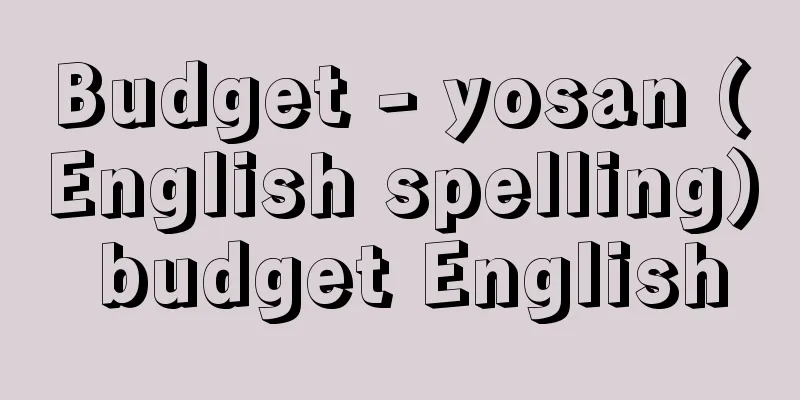Budget - yosan (English spelling) budget English

|
A financial year's plan of revenues and expenditures. The national budget is discussed here, but budgets are also commonly prepared by local governments, private companies, and other organizations. [Masatoshi Hayashi] Budget FeaturesLooking at the historical development process, the budget system played an important role in clearly distinguishing the private economy of feudal monarchs and lords from the public economy. The development of democracy is closely related to the process by which the people obtained the right to tax and spend from the king, and the budget was an effective means of controlling the king's arbitrary taxation and spending. Even in modern democratic systems, the budget is an effective tool for the legislature to control the executive branch, and this is the classic function of the budget, known as the control function, and Japan's budget system is designed to correspond to this function. On the other hand, the size of the public sector in modern welfare states has become enormous not only in absolute terms but also in terms of relative size to gross national product (GNP) and other indicators. In order to achieve efficient use of scarce resources in the entire economy, we cannot ignore the efficiency of resource use in the public sector. In the private sector, there is competition and an inherent mechanism for natural selection of inefficient production methods and goods and services that do not suit people's tastes, but the public sector does not have such a mechanism, so a systemic method of improving efficiency is necessary. Therefore, attempts are being made one after another to use budgets for efficient management of organizations and formulation of long-term plans. In contrast to the classical control function, these new functions are called management functions and planning functions, respectively. Budget systems such as program-specific budgets, PPBS, and zero-based budgets (ZBB), which were developed mainly in the United States and have actually been introduced by the federal government, are aimed at improving the efficiency of resource use in the public sector. [Masatoshi Hayashi] Budget PrinciplesIn order to ensure the effectiveness of budget functions, especially the classic control function, several budgetary principles have been established. First, the budget requires openness, clarity, and rigor. The principle of openness is closely related to the development of the parliamentary system, and as long as democracy is premised on the public having accurate information about government activities and the free criticism based on that information, it is natural that the contents of the budget should be made public to the public. The government's policies, free from any ideological embellishment, are expressed very clearly in the budget. Furthermore, if the classification method of budget items, sources of income, and purposes of expenditures are not clear, there is no point in disclosing the budget, so the principle of clarity is essential to realizing the principle of openness. The principle of rigor requires that revenues and expenditures in the budget be recorded as close as possible to the actual figures. A budget is ultimately a plan, and revenues in particular are strongly estimated, but if the budget figures differ too much from the actual figures, the budget becomes meaningless. Next, there is the principle of ex ante determination, which requires that the budget be determined before the start of the fiscal year. If the key function of the budget is to control the executive branch through the legislature, it is meaningless if it is not determined after the executive branch has made and implemented decisions on revenues and expenditures. There is also the principle of limitation. Its contents can be divided into the principle of prohibiting the diversion of funds between expense items, the principle of prohibiting overspending, and the principle of independent fiscal years. If these three limitations are violated, the budget loses its real meaning and the scope of discretionary power of the executive branch increases, making budget deliberations by the Diet meaningless and making it difficult to control the executive branch. Furthermore, there is the principle of unity, which states that priorities should be considered for all revenues and expenditures, and that in order to do so, the budget must be unified. Having numerous parallel budgets makes it difficult to grasp the overall picture, weakens parliamentary control, and makes efficient resource allocation impossible. The principle of non-affectation (règle de non-affectation) prohibits any link between specific revenues and expenditures and requires that all revenues be pooled together and spent for various expenditure purposes from a unified treasury. Additionally, the principle of completeness or total budgeting requires that all income and expenditure be included in the budget, because unaccounted income or expenditure creates a budget surplus or deficit and the lack of effective planning and control. [Masatoshi Hayashi] Budget TypeThe budget system is complex due to its size and the diversity of subjects it deals with, despite the principles of unity and clarity that are regarded as budgetary principles. Taking the Japanese budget as an example, there are divisions into the general account budget, special account budget, government agency budget, and fiscal investment and loan program. The general account is mainly for government-specific activities, but special accounts are established as an exception to the principle of unity only when the state conducts a specific business, when it holds and manages specific funds, or when it is necessary to use specific revenues for specific expenditures and to account for them separately from general revenues and expenditures. As of 2017, 13 special accounts have been established under the Special Accounts Act (Act No. 23 of 2007). Government-related organizations are fully funded by the state and are independent legal entities, and their budgets must be submitted to the Diet for deliberation and resolution. As of fiscal year 2020 (Reiwa 2), there are four such organizations: Japan Finance Corporation (a special company established in October 2008 by integrating the international finance operations of the National Life Finance Corporation, the Japan Finance Corporation for Small and Medium Enterprises, the Agriculture, Forestry and Fisheries Finance Corporation, and the Japan Bank for International Cooperation), the Okinawa Development Finance Corporation, the Japan International Cooperation Agency (loan aid division), and the Japan Bank for International Cooperation (established in April 2012 as a spinoff from the Japan Finance Corporation). The Fiscal Investment and Loan Program is a plan for the government's financial investment activities, and since 1973 (Showa 48), all of its original funds have been subject to Diet resolution. In 2000, the Fund Management Department Fund Law and other laws were amended to rename it the Fiscal Investment and Loan Program Special Account, and significant system reforms were made, including the abolition of the Fund Management Department and the establishment of the Fiscal Investment and Loan Program Fund, the abolition of the full deposit requirement for postal savings and pension reserve funds, and the issuance of Fiscal Investment and Loan Program bonds, among others, by Diet resolution. From the fiscal year 2008, the Act on Special Accounts made it the Fiscal Investment and Loan Program Special Account. In order to respond to changes in circumstances after the main budget has been enacted, supplementary budgets may be prepared. In addition, although budgets are supposed to be enacted before the start of the fiscal year, this may not be possible in the event of political turmoil. However, because it is not desirable for administrative functions to cease, a provisional budget system has been established to continue minimal administrative functions during the blank period. According to the Financial Law, the budget proposal submitted by the Cabinet to the Diet consists of five items: the general budget provisions, the revenue and expenditure budget, continuing expenses, carryover authorized expenses, and treasury obligations. The general budget provisions are comprehensive provisions on the budget, and stipulate the necessary matters for budget execution, such as the amounts of the revenue and expenditure budget, continuing expenses, and treasury obligations, the limits on bonds and borrowings, and the scope of public works expenses to be covered by bonds. The continuing expenses system is a system in which the total amount of necessary expenses, the number of years required, and the annual amount for projects that require more than one year are approved in advance by the Diet. The carryover authorized expenses are a system that allows expenditures to be carried over to the following fiscal year as an exception to the principle of expenditure within the fiscal year. In addition, the treasury obligations are a system in which the Diet is approved for actions that may require cash expenditures in the future other than the expenditure budget and continuing expenses. [Masatoshi Hayashi] Budget processThe annual budget goes through a series of steps including compilation, deliberation, execution, and settlement. This process is called the budget process, and it usually takes about three years. Below, we will explain the budget process in Japan. [Masatoshi Hayashi] OrganizationUnder the Constitution, the Cabinet has the power to formulate the national budget, i.e., the authority to prepare the budget and submit it to the Diet. Within the Cabinet, the former Ministry of Finance played a central role, but with the reorganization of central government ministries and agencies in January 2001, the Cabinet Office (including the Council on Economic and Fiscal Policy) took control of the budget, and the power of the Ministry of Finance, which took over from the Ministry of Finance, declined relatively. Since the revenue budget is mainly an estimate of income, the main part of the budget compilation work is the expenditure budget. First, the head of each ministry or agency submits a budget request. The head of each ministry or agency is required to prepare documents related to estimates of revenues, expenditures, continuing expenses, carryover authorized expenses, and national debt obligations under his or her jurisdiction and submit them to the Minister of Finance (formerly the Minister of Finance). This is called a budget request, and the deadline for submitting it is August 31 of the previous fiscal year. The Minister of Finance reviews the budget requests sent by the heads of each ministry and agency, makes any necessary adjustments (so-called budget assessment), and the Ministry of Finance puts together a draft budget in accordance with the "budget formulation guidelines" decided by the Cabinet (when it was the Ministry of Finance, it was called the Ministry of Finance draft). Based on this, the Ministry of Finance and each ministry and agency enter into revival negotiations, at which point the overall limit on the amount of revival that will be made public. Revival negotiations are the process of allocating these public financial resources. The budget estimate is then decided by the Cabinet. Based on the budget estimates approved by the Cabinet, the Minister of Finance prepares a detailed revenue budget statement showing the contents of the revenue budget. Similarly, the heads of each ministry and agency prepare requests for planned expenses, continuing expenses, authorized carryover expenses, and national debt obligations showing the contents of the expenditure budget, and send them to the Minister of Finance. The Minister of Finance prepares the budget based on these and submits it to the Cabinet for approval. The timing of budget preparation is limited by the timing of budget submission to the Diet, and the Financial Law stipulates that the budget for each fiscal year is usually submitted to the Diet in January of the previous fiscal year. Special procedures have been established for the budgets of the Diet, the courts, and the Board of Audit, which are independent organizations, so as not to restrict their activities. [Masatoshi Hayashi] DeliberationsThe budget must first be submitted to the House of Representatives. This is called the House of Representatives' right to consider the budget first. Once the budget is passed in a plenary session of the House of Representatives after deliberation in the Budget Committee, it is sent to the House of Councillors. Similar deliberation is also held in the House of Councillors, and the budget becomes law when it is passed in a plenary session of the House of Councillors. There is no limit to the period of deliberation in the House of Representatives, but the House of Councillors has a provision that if it does not act within 30 days after receiving the budget passed by the House of Representatives, excluding periods when the Diet is in recess, the decision of the House of Representatives becomes the decision of the Diet, and the budget becomes law. Furthermore, if the House of Councillors makes a decision that differs from that of the House of Representatives, a conference of both houses is held to try to pass a compromise bill, but if there is still no agreement, the decision of the House of Representatives becomes the decision of the Diet, and the budget becomes law. The reason why the budget is passed more easily than ordinary bills is that the budget is valid for only one year, and its failure to pass or its delay in passing has a significant impact on the running of national politics and, ultimately, on the lives of the people. [Masatoshi Hayashi] ExecutionThe third step in the budget process is budget execution, which consists of two stages: allocation and execution. When the budget is enacted, the Cabinet allocates to each ministry and agency the revenue and expenditure budget, continuing expenses, and treasury debt obligations that each should execute, and this action is called budget allocation. Budget execution consists of expenditure obligations, expenditures, and payments, and payments are generally made by issuing checks made out to the Bank of Japan. [Masatoshi Hayashi] settlement of accountsThe final stage of the budget process is the final settlement of accounts. By July 31st, the head of each ministry or agency must prepare a final account report for their respective revenues and expenditures, as well as a statement of the national debt, and send them to the Minister of Finance. The Minister of Finance will prepare a final account of revenues and expenditures based on these and send it to the Board of Audit by November 30th. The Board of Audit will review these, investigate the actual state of budget execution, and prepare an audit report. It is customary for the Cabinet to submit the final account of revenues and expenditures after audit by the Board of Audit to the Diet at the opening of an ordinary session in the following fiscal year. The House of Representatives is not required to take priority in the deliberation of the final accounts in the Diet. In cases of fraudulent or improper use of the budget, the government can be held accountable by resolution, but this is not legally binding. [Masatoshi Hayashi] "Zero-Based Management" by P.A. Peer, translated by Nakamura Yoshio (1977, Diamond Publishing)" ▽ "Public Finance" by Kawasaki Akinori (1995, Kobundo)" ▽ "Illustrated National Budget Structure" edited by Katayama Taisuke (1999, Toyo Keizai Shinposha)" ▽ "Fiscal Policy of Decentralized Democratization - The Social System of the 21st Century" by Endo Saburo (2000, Chuo Keizai Publishing)" ▽ "Budget System, New Edition, Second Edition" by Kono Kazuyuki (2001, Gakuyo Shobo) [Reference items] | | | | | | | Program| | | | | | | |Source: Shogakukan Encyclopedia Nipponica About Encyclopedia Nipponica Information | Legend |
|
歳入と歳出についての、一会計年度に対する計画書。ここでは国の予算について述べるが、予算は地方公共団体、民間企業およびその他の組織においても一般的に作成されている。 [林 正寿] 予算の機能歴史的発展過程をみると、封建時代の君公・領主の私経済と公経済を明確に区別するために予算制度は重要な役割を果たした。民主主義の発展は、国民による国王からの課税協賛権や支出協賛権の獲得の過程と密接な関係を有しており、国王による恣意(しい)的課税や支出を統制するための有効な手段が予算であった。現代の民主主義制度においても、予算は行政府を立法府が統制するための有効な道具であるが、これが統制機能とよばれる予算の古典的機能であり、日本の予算制度もこの機能に対応してつくられている。 他方、現代の福祉国家における公共部門の規模は、絶対的にはもちろん、国民総生産(GNP)などに対する相対的規模などの指標でみても膨大化しており、経済全体の希少資源の効率的利用を達成するためには、公共部門における資源利用の効率性を等閑視するわけにはいかない。民間部門には競争が存在し、効率性の悪い生産方式や人々の好みにあわない財・サービスを自然淘汰(とうた)するメカニズムが内在しているが、公共部門にはそのようなメカニズムがないから、制度的に効率性を改善するくふうが必要となる。そこで、組織の効率的管理や長期計画の策定への予算の利用が次々と試みられている。古典的な統制機能に対して、これらの新しい機能は、おのおの管理機能と計画機能とよばれている。主としてアメリカで発展し現実に連邦政府などに導入された事業別予算、PPBS、ゼロベース予算(ZBB)などの予算制度は、公共部門の資源利用の効率性の改善を目的としたものである。 [林 正寿] 予算原則予算の機能、とくに古典的機能である統制機能を有効ならしめるために、いくつかの予算原則が定められている。 まず、予算には公開性、明瞭(めいりょう)性、厳密性が要請される。公開性の原則は、議会制度の発展と密接な関係をもっているが、民主主義が政府活動についての国民の正確な情報とそれに基づいた自由な批判を前提とする限り、予算内容が国民に公開されるのは当然のことである。イデオロギーのあらゆる粉飾を除いた政府の政策が、予算にはきわめて明白に表現されている。また、予算項目の分類方法、収入源や支出目的などについて明瞭でなければ、公開しても意味がないから、明瞭性の原則は、公開性の原則を実質化するために不可欠である。厳密性の原則は、予算における歳入額および歳出額を、できる限り実績値に近くなるように計上すべきことを要請する。予算はしょせんは計画であり、とりわけ歳入については見積額の性格が強いが、あまり実績額と異なる予算額では予算の意味がなくなる。 次に事前決定の原則がある。これは、予算が会計年度開始以前に決定されることを要請する。予算の重要な機能が立法府による行政府の統制にあるとすれば、行政府が歳入や歳出について決定し実施したあとでは意味がない。 また、限定性の原則がある。その内容は、費用項目間の流用禁止の原則、超過支出禁止の原則、会計年度独立の原則に分けることができる。この三つの限定性が侵されると、予算は実質的な意味を失い、行政府の自由裁量の幅が広がるから、議会による予算審議は意味のないものとなり、行政府を統制することが困難になる。 さらに単一性原則がある。歳入および歳出の全体を対象として優先順位を考えるべきであり、そのためには予算は一本化しなければならないという原則である。数多くの予算が並立することは、全体像の把握を困難とし、議会による統制を弱め、効率的資源配分を不可能にするからである。 ノン・アフェクタシオンの原則règle de non-affectation(フランス語)は、特定の収入と支出の間の結び付きを禁止し、あらゆる収入をひとまとめにして、統一的国庫のなかから各種歳出目的への支出を行うべきことを要請する。 また、完全性の原則や総額予算主義の原則とよばれる原則は、収入にせよ支出にせよ、すべてを予算に計上すべきことを要請する。計上されない収入または支出があると、予算余剰または不足を生み出し、有効な計画や統制が失われるからである。 [林 正寿] 予算の種類予算の仕組みは、予算原則とされる単一性の原則や明瞭性の原則にもかかわらず、その膨大さと扱う対象の多様性のゆえに複雑である。 日本の予算を例にとると、一般会計予算、特別会計予算、政府関係機関予算、財政投融資計画の区分がある。一般会計は主として政府固有の活動を対象とするが、特別会計は単一性の原則に対する例外として国が特定の事業を行う場合、特定の資金を保有してその運用を行う場合、その他特定の歳入をもって特定の歳出にあて一般の歳入歳出と区分して経理する必要がある場合に限り設置されるものであり、「特別会計に関する法律」(平成19年法律第23号)により、2017年(平成29)時点で13の特別会計が設置されている。 政府関係機関は、国が全額出資している独立の法人格をもつ企業であり、その予算は国会に提出して、審議と議決を経なければならない。2020年度(令和2)時点では、日本政策金融公庫(2008年10月に国民生活金融公庫、中小企業金融公庫、農林漁業金融公庫および国際協力銀行の国際金融等業務を統合することによって設立された特殊会社)、沖縄振興開発金融公庫、国際協力機構(有償資金協力部門)、国際協力銀行(2012年4月に日本政策金融公庫から分離して発足)の4機関がある。 財政投融資計画は政府の金融的投資活動についての計画であり、1973年(昭和48)以降はその原資のすべてが国会の議決対象となった。2000年には資金運用部資金法等が一部改正されて財政投融資特別会計と改名され、資金運用部の廃止と財政投融資資金の設置、郵便貯金・年金積立金の全額預託義務の廃止、財投債の発行等が国会決議され、かなりの制度改革がなされた。2008年度会計からは「特別会計に関する法律」により、財政投融資特別会計となった。 本予算が成立したあとの状況変化に対応するために、補正予算が編成されることがある。また、予算は会計年度の開始前に成立することがたてまえではあるが、政治的紛糾のある場合にはこのことが不可能なことがある。しかし、行政機能が停止することは望ましくないから、その空白期間における最小限の行政を継続するために、暫定予算制度が設けられている。 財政法の規定では、内閣が国会に提出する予算案は予算総則、歳入歳出予算、継続費、繰越明許費、国庫債務負担行為の5項目からなる。予算総則とは、予算についての総括的な規定であり、歳入歳出予算、継続費や国庫債務負担行為の各金額、公債および借入金の限度額、公債によってまかなわれる公共事業費の範囲などの予算執行のための必要事項が規定されている。継続費の制度は、1年以上を要する事業について必要経費の総額、所要年数、年割額などについて、あらかじめ国会の承認を得ておく制度である。繰越明許費は、年度内支出の原則の例外として、翌年度に繰り越して支出を認める制度である。また、国庫債務負担行為は、歳出予算額、継続費額以外で将来において現金の支出を必要とするかもしれない行為について国会の承認を得ておく制度である。 [林 正寿] 予算過程毎年度の予算は編成、審議、執行、決算という一連の過程を経るが、この過程が予算過程とよばれるものであり、通常は3年くらいを要する。以下、日本の予算過程について解説する。 [林 正寿] 編成憲法上、国の予算の編成権、すなわち予算を作成して国会に提出する権限は内閣にあるとされている。内閣の内部においては、旧大蔵省が中心的役割を演じてきたが、2001年(平成13)1月の中央省庁再編を機に、内閣府(経済財政諮問会議など)が予算編成権を握り、大蔵省を引き継いだ財務省の力は相対的に低下した。 歳入予算は収入の見積作業が主であるから、予算編成作業の中心は歳出予算にある。まず、各省庁の長による概算要求が行われる。各省庁の長は、その所掌にかかわる歳入、歳出、継続費、繰越明許費および国庫債務負担行為の見積りに関する書類を作成し、財務大臣(旧、大蔵大臣)に送付しなければならないとされている。これを概算要求といい、その送付の期限は前年度の8月31日とされている。 財務大臣は、各省庁の長から送付された概算要求を検討して必要な調整(いわゆる予算の査定)を行い、閣議で決定された「予算編成方針」に従って財務省が原案をまとめる(大蔵省時代は大蔵原案とよばれた)。これに基づいて財務省と各省庁との復活折衝に入るが、その際、復活に応ずる全体の限度額を公開する。復活折衝は、この公開財源の配分の過程である。その後、予算概算が閣議決定される。 閣議で決定された予算概算に基づいて、財務大臣は、歳入予算の内容を示す歳入予算明細書を作成する。また、同じく各省庁の長は、歳出予算の内容を示す予定経費要求書、継続費要求書、繰越明許費要求書および国庫債務負担行為要求書を作成し、財務大臣へ送付する。財務大臣は、これらに基づいて予算を作成し、閣議の決定を受ける。 予算の編成の時期は、予算の国会提出の時期によって限定されるものであり、財政法では、毎会計年度の予算は前年度の1月中に国会へ提出するのを常例とすると定めている。なお、独立機関である国会、裁判所、会計検査院の予算は、その活動を制約しないように特別の手続が定められている。 [林 正寿] 審議予算は、先に衆議院に提出しなければならない。これを衆議院の予算先議権という。衆議院において、予算委員会の審議を経て、予算が衆議院本会議で可決されると、参議院に回付される。参議院においても同様な審議を行い、参議院本会議で可決されると予算が成立する。審議期間は衆議院には制限がないが、参議院には、衆議院の可決した予算を受け取ったのち国会休会中の期間を除いて30日以内に議決しないときは、衆議院の議決が国会の議決となるという自然成立の規定がある。また、参議院が衆議院と異なった議決をした場合は、両院協議会を開いて妥協案の成立を図るが、それでも意見が一致しないときは、衆議院の議決が国会の議決となり、予算は成立する。 このように、予算の成立について一般の法律案よりも容易にしているのは、予算が1年限りのものであり、かつその不成立または成立の遅延が国政の運営、ひいては国民生活に重大な影響を及ぼすからである。 [林 正寿] 執行予算過程の第三過程は予算の執行であるが、配賦(はいふ)と執行の二段階からなる。予算の成立とともに、内閣は各省庁の長に対してそれぞれが執行すべき歳入歳出予算、継続費、国庫債務負担行為などについて配分するが、この行為を予算の配賦とよぶ。予算の執行は支出負担行為、支出、支払いからなり、支払いは日本銀行を支払人とする小切手の振出しによって行われるのを原則とする。 [林 正寿] 決算予算過程の最後の段階は決算であるが、7月31日までに、各省庁の長は、それぞれの歳入および歳出の決算報告書および国の債務についての計算書をつくって財務大臣に送付する。財務大臣はこれに基づいて歳入歳出決算を作成し、11月30日までに会計検査院に送付する。会計検査院はこれらを審査して、予算執行の実態を調査したうえで、検査報告書を作成する。内閣は会計検査院の検査を経た歳入歳出決算を、翌年度開会の常会において国会に提出するのを常例とする。国会における決算の審議については、衆議院の優先性は要請されていない。不正あるいは不当な予算の使用があるときには、決議によって政府の責任を問うことはできるが、法的拘束力はない。 [林 正寿] 『P・A・ピアー著、中村芳夫訳『ゼロベース・マネジメント』(1977・ダイヤモンド社)』▽『川崎昭典著『財政学』(1995・弘文堂)』▽『片山泰輔編著『図解国家予算のしくみ』(1999・東洋経済新報社)』▽『遠藤三郎著『分権民主化の財政政策――21世紀の社会システム』(2000・中央経済社)』▽『河野一之著『予算制度 新版 第2版』(2001・学陽書房)』 [参照項目] | | | | | | | | | | | | | | |出典 小学館 日本大百科全書(ニッポニカ)日本大百科全書(ニッポニカ)について 情報 | 凡例 |
<<: Budget Committee - yosaniiinkai (English spelling) budget committee
>>: Night monkey - Night monkey
Recommend
Pascal's triangle - Pascal's triangle
The coefficients of a binomial expansion are arran...
Ceramic tools - Ceramic tools
There are three types of tools made of ceramic ma...
Lophius litulon (English spelling) Lophiuslitulon
...It reaches a total length of about 1m. The yel...
Hedychium gardnerianum (English spelling) Hedychiumgardnerianum
… [Mitsuru Hotta]... From [Hanasukusha] …[Ichiro ...
Litonia
A non-cold-tolerant bulbous plant of the lily fami...
Ezokusaichigo - Ezokusaichigo
... F . iinumae Makino grows in clusters in sligh...
Jurisdiction - Court of jurisdiction
The term "court" refers to a court that ...
Creation myth of the country
One of the Japanese myths. The myth tells of how t...
Spelling class - Spelling class
A collection of Toyoda Masako's writings. Toyo...
Yasuo Kuniyoshi
A Japanese painter who was active in the American...
ESCA (Esca)
...The one that uses X-rays is called X-ray photo...
Lantern fly
…Many species have beautiful colors and patterns ...
computer network
A state in which multiple computers are connected ...
Turn yourself in
A person who has committed a crime voluntarily re...
bhukti
The Gupta Empire reorganized the Indian ruling sy...









